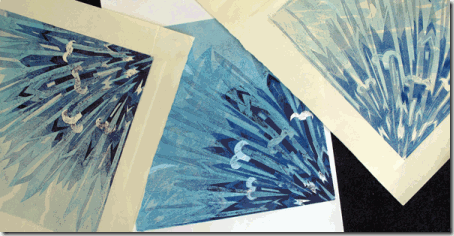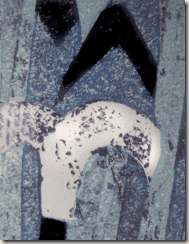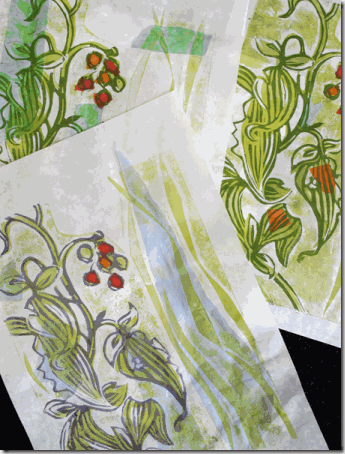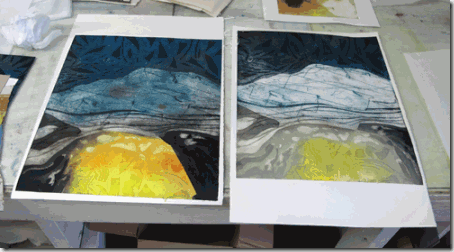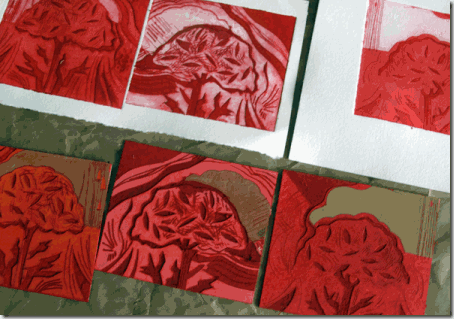Back in 2015 I started experimenting with prints based around the Bird Cherry tree in the garden. I intended to make one print for each month to chart the changes. It was more a way of experimenting with techniques than actually producing a thing, and as with many projects, this one got overtaken by other work.
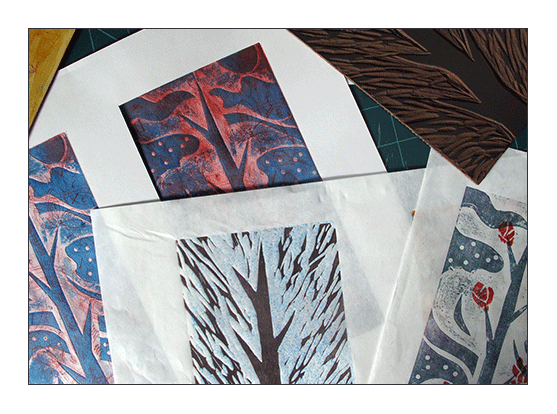
These are the first few proofs for possible January and February images. They are all based around one twig of this thorny little tree which I am not so keen on but the birds (yes, the clue is in the name) do love…and so do the bees, so it has to stay. Currently I am trying to improve my bookbinding skills and am attending a short course with the excellent Sue Doggett at City Lit.
Knowing we were going to be looking at Japanese stab binding on Monday galvanised me into picking up this almost forgotten project. Going back to the prints made me realise how much my understanding of printmaking has improved but there was no time to remake the prints, just to finish the last 3 months..oh and the cover and the endpapers and the text .. etc etc.
The full set of Bird Cherry prints, all printed on Japanese paper. The print size is 20 cm x 10 cm.
They are mostly collagraphs with the odd lino and woodcut thrown in. They are printed on Japanese paper, trimmed and tipped in. My printing is still rather erratic so this seemed to be the best way to get a decent set.
Tipped in prints and a text page.
Text, endpaper and January print.
The text is also printed on Japanese paper, for its lovely translucent quality. The image pages are French folded Japanese paper, so bound on the unfolded edge and the end papers were made from a spare plate I had made as a background for another project.
The great thing about working with a professional is that you get to do things correctly and are shown things that suddenly open up a whole bunch of other possibilities. I have done some simple Japanese binding before but never added these very neat little corner pieces.
or made an internal binding to hold the pages together before the final binding.
The cover was printed with the same thorny image as the endpapers, thorns are very apt for this tree, and laminated onto thin card, I agonised about the reverse of the cover but the card was dark grey and smooth and looked too dull against the textures and colours of the prints and other papers, so I laminated that too with plain Japanese paper. Much better.
The cover title was set into a recessed rectangle and then everything was punched to make a classic 4 hole stab binding and bound with olive green hemp string I happened to have. NIce!
Bird Cherry: 12 Calendar Prints of the Bird Cherry: Prunus padus: 25 pages, tipped in hand printed plates, hand printed cover and endpapers. 225 x 290 mm. Hand bound.
Translucent endpaper.
Print for April when this little tree is covered in white blossom before the leaves appear.
I had allowed for the binding in the page size so this book opens pretty well. It is one of the drawbacks of this binding that it cannot open entirely flat, but if the pages are big enough and the paper flexible it works OK. Yes I am pleased.. and relieved to actually get something finalised.

